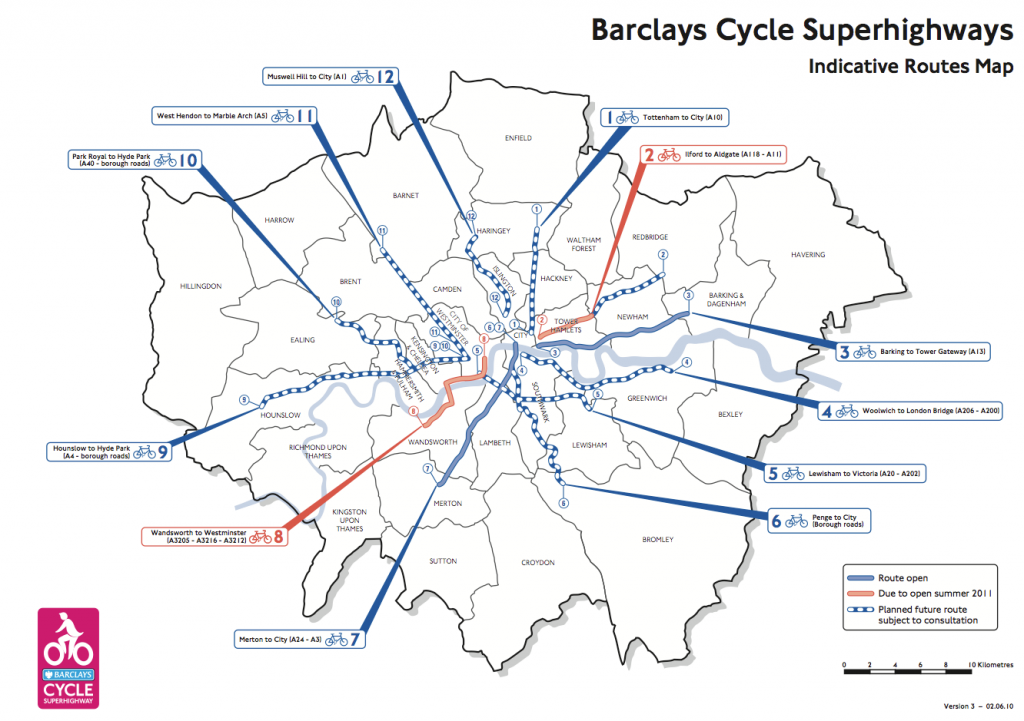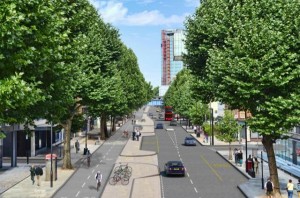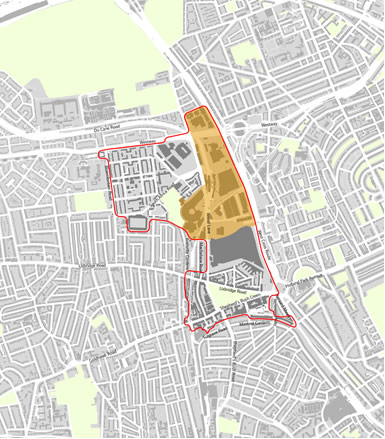One. Two. Three. Four. Four people cycling on main roads in London. Four deaths. The first two in a single day last week, and two more in the past two days makes four cycling deaths in just over a week in London. Five in the UK as a whole. I’d written this post as a draft before the first, and each time another died I wasn’t sure what to write. These aren’t just numbers, these are people with families and friends touched by immeasurable shock and sorrow. The fact that four deaths should happen in so short a space of time is to an extent a random outcome of the dangers on our roads. That said, our roads should not be this random, chaotic and dangerous.
There were near misses in the past week as well, with combinations of luck and bystanders intervening saving lives not once, not twice, but three times. And then there are the incidents that don’t make the news including one close to home on King Street in Hammersmith. I’d expect all of these to likely be classed as KSIs, as they involved either a death or a serious injury. I suspect my merely being run over on Hammersmith Gyratory and receiving road rash on my face was a ‘slight injury’, for at least my life wasn’t in danger (the measure of a KSI) – or was it? Had I landed a lane either side I would have been swiftly run over, but I digress.
Each of the collisions I’ve linked from the last week have taken place on a main road. Many in the centre of a city where by far the majority of people are not using motor vehicles for transport. Three of them have take place along the Cycle Superhighways. On those and many others we have roads where space has been reallocated since the 90s as part of providing bus priority and tram schemes.
We have spent decades trying to use paint, training and advertising to encourage more people to cycle. However there is no comprehensive programme, plan or standard with which roads are to be designed which cycle campaigners can say delivers safety. London, and the rest of the UK needs to urgently reassess the way in which space upon main roads is allocated.
Why should we alter our main roads for cyclists? Even this morning as LBC (London’s Biggest Conversation, a radio station) tried to discuss cycle and pedestrian safety they and their callers showed again that whilst the idea of segregation or “going dutch” is reaching beyond the cycling community the wider ideas have not been understood. It is hard not to get angry that whilst they talked up the danger, their presenter confessed he hadn’t researched how bus drivers are trained. This meant he relied on the view of a single recently trained driver who phoned in. Though by far the most bizarre moment came as in a discussion of bus safety with Leon Daniels where a figure was quoted for KSIs per kilometre and he took him to task for using the metric system. Thankfully then the hour of LBC my radio alarm had inadvertently given me was up and the radio switched off.
What are we seeking? Well, the idea behind “Love London, Go Dutch” and now Space4Cycling is relatively straightforward. It is to remind ourselves that the layout and structure of our roads, our cities and communities is not fixed. We have seen many changes in London but in most cities over the years. Some have favoured buses, some the private motor car, and in places like Edinburgh we see the issues already from trams (as yet not in passenger service) being added to a city with a modest cycling level. We have no problem as a country, or cities in changing our roads but what we haven’t done is any comprehensive programme to handle that for cycling.
As a campaigner it’s always hard to know where to begin, but let’s take the main roads, and look at the history of superhighways to understand where we are, and where we could be. Superhighway – what do we mean? Looking at the diversity of treatments in London it is easy to conclude that the ‘Superhighway’ is only branding beneath which modest changes have been made. That said, no interventions on main roads for cycling in London have had a higher budget than the superhighways.
The TfL programme for Superhighways first became public near the end of Ken Livingstone’s second term in early February 2008. The plan then was for one in place by 2010 with five in total by 2012. Here’s a video of Ken launching bike hire and cycle superhighways. You may spot Jenny Jones in the background who at the time was Deputy Mayor of London.
At that time Ken spoke of “dedicated routes for cyclists, where they won’t be in competition with Heavy Goods Vehicles” i.e. segregation in some form “linking up suburban town centres” which is rather like the mini-holland programme underway now and that “for every person who cycles in London there’s another seven who’ve got a bike at home they don’t use” a statistic probably still fairly similar now five years on. I can’t embed it, but there’s a longer version of the launch here, in it the presenter questions Ken Livingstone and asks if the routes will be consistent for long journeys though dangerous junctions. Ken was very clear that you needed funding of £500m to do exactly that. He noted that boroughs would have to be brought on board. The explicit problem there being that responsibility for the roads is split between local authorities and TfL. The implicit problem being that London isn’t a city state and must work within the Department for Transport rules.
Ken then lost the election to Boris Johnson, in May 2008. Amusingly, as so often in British politics the colour of the hire bikes changed and went from “a distinctive London bright red bike” under Ken Livingstone to blue under Boris Johnson. TfL say the colour used on superhighways was chosen primarly for wayfinding reasons, as in this FOI request states. Through Boris’s first term the hire bikes were a pretty rapid and clear change in cycling in the centre of London, the superhighways meanwhile terminated before they reached the centre of town. Ken’s view of this approach was not particularly favourable.
He wondered about the cycle hire scheme and said of it that they “don’t know where that went wrong”, and that the cost was excessive. Boris would insist that due to his inability to get advertising around the bike hire as in other cities.
Regardless, this meant a lot of cycling money was spent on proving hire bikes rather than providing safe routes.
 Speaking of safe routes, the superhighways saw slow progress. The rough plan as it emerged in Boris’s first term was to have a ‘clock face’ of routes with numbering roughly in clock style. You can see the borough boundaries on the map here, on the ground some of the lengths of road used by TfL for the superhighways were under their control, and some weren’t. The first pair of pilot routes (CS3 and CS7) were delivered in 2011, and at the time that it was being delivered Jenny Jones AM reviewed the in progress Cycle Superhighway 7 near Oval.
Speaking of safe routes, the superhighways saw slow progress. The rough plan as it emerged in Boris’s first term was to have a ‘clock face’ of routes with numbering roughly in clock style. You can see the borough boundaries on the map here, on the ground some of the lengths of road used by TfL for the superhighways were under their control, and some weren’t. The first pair of pilot routes (CS3 and CS7) were delivered in 2011, and at the time that it was being delivered Jenny Jones AM reviewed the in progress Cycle Superhighway 7 near Oval.
Jenny stands next to the nearly finished Superhighway 7 and says (2m5s in): “i think it’s obviously going to have to be improved before the launch … I just don’t know what’s going to happen up here at the traffic lights where the cyclists have got to move over to the right, into the traffic.” But what happened? this.  Blue paint in the bus lane, but as the cyclists need to go straight on they simply see blue paint disappear from one lane then appear in another, and have to negotiate over to follow it. However, as they have joined a lane which is both a lane for going ahead and left they come into conflict with left turning traffic. This was observed in action, as seen in 2012.
Blue paint in the bus lane, but as the cyclists need to go straight on they simply see blue paint disappear from one lane then appear in another, and have to negotiate over to follow it. However, as they have joined a lane which is both a lane for going ahead and left they come into conflict with left turning traffic. This was observed in action, as seen in 2012.
These are not issues that can be overcome I feel by training, hi-viz or lights. The issue is the design of the road. TfL under Boris was changing the design of roads, but it was too timid in the changes it made. Some of that was the wider framework they operated under within the UK, but they didn’t do much to challenge it.
Superhighway 2 was also delivered to a very poor standard. I won’t rehash the arguments of how poor that was, as I think the example I’ve given of Superhighway 7 shows the kind of failings that occur when you rely on blue paint to provide cyclists with safety and priority. It was Superhighway 2 that proved to cause the biggest trouble for the programme. In the space of three weeks in late 2011 there were two deaths near Bow Roundabout.
Campaigners who had been concerned at the quality of the superhighway programme have naturally campaigned before and since these and other deaths. TfL meanwhile has reacted slowly, first offering changes at Bow Roundabout, then agreeing with the London Cycle Campaign on changes at Aldgate. Then in tragic timing first launching plans to rework existing superhighways the day after a death on Superhighway 2 and holding a conference on cycling on the same day as the death in Croydon. It barely needs pointed out, but action from the Mayor has come slowly and clearly should have come sooner. Even now TfL are launching extensions to CS2 they remain unhappy with,
that they don’t see as perfect, and little wonder why. To be effective the Superhighways and all other delivered routes need first to be adequate for the task in hand by being continuous and safe through whatever transitions in style of provision may be necessary. But also they must plan to ensure they update and improve what they deliver regularly. That is part of what the Netherlands does so well, beyond the high basic standard to which they deliver all cycling infrastructure. The job doesn’t end on the day you open a superhighway or improvements to it, it merely continues.
Now, the latest plans build on proposals made in the Mayor’s Cycling Vision which did represent the start of a step forward. Since the launch of the vision there have been extensive trials at the Transport Research Laboratory, a large scale project to rework the London Cycle Design Standards and discussions with boroughs on various plans. The problem is that as much as there has been progress, many boroughs are still being resistant especially at the political level. Standards are still being reworked and action is needed now. Whilst TfL must try to balance competing demands it continues to appear that cycling is not yet being designed into their plans, and plans risk being watered down. At some point in the near future the Department for Transport must decide upon the way forward after the trials TfL has funded, and which interventions will be approved. We risk further compromises and the while we are paying dearly for the time wasted in Boris Johnson’s first term. It’s a terrible situation, but I have no sympathy for Boris Johnson as he is currently in a situation he was repeatedly warned of. That said, we must not overlook the veto that the Department for Transport effectively has and has had on tackling safety in London.
City Hall admits the Department for Transport has not yet signed up to the new cycle junctions. @itvlondon — Simon Harris (@simonharrisitv) November 6, 2013
Compromises in London and elsewhere feel to me to have had two effects:
- Placing those cycling on main roads at a higher risk than otherwise.
- Depressing the cycling rate by making it less attractive.
Now, we shouldn’t either overlook the block that local councils represent to making change happen on London streets. Regular cyclists know the borough boundaries well, they’re where provision often ceases or suddenly declines in quality at present. This is still set to continue. A great example of this local to me is the Cycle Superhighway 9. This was/is set to run from Hyde Park to Hounslow. It has run into remarkable resistance in Kensington and Chelsea. Rather like with the Bow Roundabout there are few conceivable alternate routes.
The map shows Kensington High Street and surrounds with local cycle facilities (mostly on street lanes) in blue. Note where they stop. The yellow cycle symbols are bike shops, other than those and bike parking bikes simply aren’t welcome. No cycling is permitted in Holland Park, and at its western edge it runs all the way from Holland Park Avenue to Kensington High Street. There isn’t a sensible alternative nearby to avoid Kensington High Street. Even if there were, the streets in the area are aligned in ways that mean even a prioritised route would inevitably be much slower than using the main roads for East-West journeys. The only conceivable solution to cycle safety is to deal with the main roads. The likely main flow is always going to be on the main roads here. Kensington High Street is inevitably where many people who cycle are, but cycling along Kensington High Street is a heightened and terrifying experience. It doesn’t need to be.
Cycling on Kensington High Street as it is now.
Like Westminster, Kensington and Chelsea objected to the use of blue paint in what they considered to be historic streets. Today’s mock-ups of the north-south superhighway give a rough idea of the kind of thing that TfL has proposed to Kensington and Chelsea in response, and sadly they have also objected to. It would involve a segregated track on one side of the road, with bus stops over that in lay-bys along with cycle parking and then a narrowed road on the far side. This removes a huge number of potential conflicts for cyclists and those that remain are clearer. For example, drivers turning off this road would enter a highlighted section for leaving the high street. It’s impossible to comment further without specific plans to review but that’s an idea of what concerted changes could achieve on Kensington High Street alone, and this is a route which would also need to address issues along miles of route from Hyde Park to Hounslow.
So how would I round up? I’ve been run over on London’s roads – twice. It has only deterred me but I know of few who regularly and happily cycle in my city. Fewer still by proportion in my country. I have seen for myself what a comprehensive network of cycle facilities looks like by visiting the Netherlands. It isn’t segregated lanes door to door, but it also isn’t just whacking down paint in the edge of the road or adding cyclists in conflicting directions to pedestrians at traffic lights. It is a network rather than a series of disjointed routes. It is about having a comprehensive plan and objective to make cycling as safe as possible, and then reaping rewards ranging from health to a more pleasant atmosphere whilst more directly controlling the more dangerous traffic. It doesn’t mean taking away anyone’s car, nor should it mean destroying the bus route you depend upon but it does mean finding a safe space in our roads where cycling is a genuine option, for all. But to explain that in detail is another post entirely and – I fear – quite a lot of video.
The London Cycling Campaign are organising a protest tonight at Bow Roundabout. They’re calling for changes to the roundabout there for both cyclists and pedestrians. The Bow Roundabout has seen inadequate and compromised changes before. It has now seen three deaths in two years, both before and with those changes. We need to get changes right, and avoid compromise.




![EyeTVSnapshot[189]](http://cdn.nuttyxander.com/wp-content/uploads/2013/07/EyeTVSnapshot189-300x168.jpg)
![EyeTVSnapshot[190]](http://cdn.nuttyxander.com/wp-content/uploads/2013/07/EyeTVSnapshot190-300x168.jpg)
![EyeTVSnapshot[91]](http://cdn.nuttyxander.com/wp-content/uploads/2013/07/EyeTVSnapshot91-300x168.jpg)